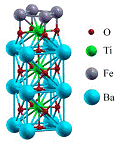Department of Physics and Astronomy: Publications and Other Research
Date of this Version
12-26-2017
Citation
PHYSICAL REVIEW B 96, 245423 (2017).
DOI: : 10.1103/PhysRevB.96.245423
Abstract
Two-dimensional electron gases (2DEG) at oxide interfaces, such as LaAlO3/SrTiO3 (001), have aroused significant interest due to their high carrier density (∼1014 cm−2) and strong lateral confinement (∼1 nm). However, these 2DEGs are normally hosted by the weakly dispersive and degenerate d bands (e.g., Ti-3d bands), which are strongly coupled to the lattice, causing mobility of such 2DEGs to be relatively low at room temperature (∼1 cm2/Vs). Here, we propose using oxide host materials with the conduction bands formed from s electrons to increase carrier mobility and soften its temperature dependence. Using first-principles density functional theory calculations, we investigate LaScO3/BaSnO3 (001) heterostructure and as a model system, where the conduction band hosts the s-like carriers. We find that the polar discontinuity at this interface leads to electronic reconstruction resulting in the formation of the 2DEG at this interface. The conduction electrons reside in the highly dispersive Sn-5s bands, which have a large band width and a low effective mass. The predicted 2DEG is expected to be highly mobile even at room temperature due to the reduced electron-phonon scattering via the inter-band scattering channel. A qualitatively similar behavior is predicted for a doped BaSnO3, where a monolayer of BaO is replaced with LaO. We anticipate that the quantum phenomena associated with these 2DEGs to be more pronounced owing to the high mobility of the carriers.


Comments
Copyright 2017 American Physical Society. Used by permission.